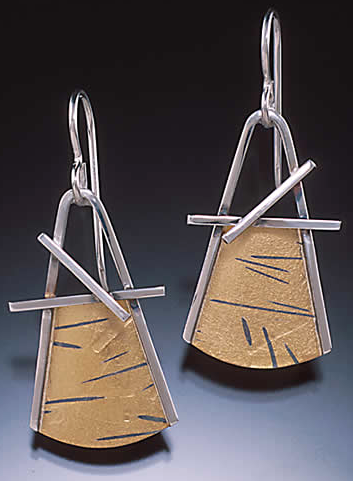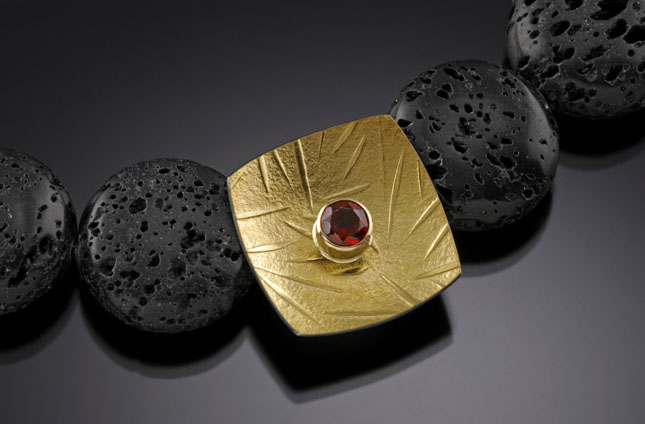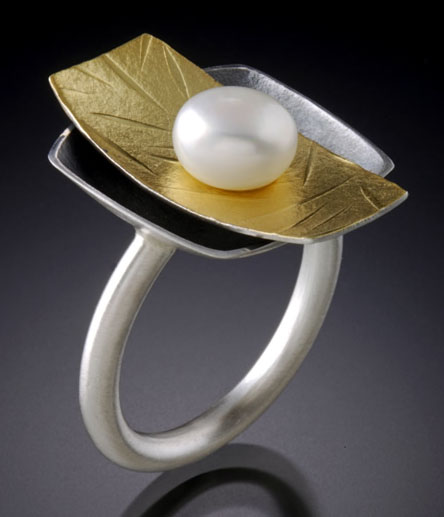 There’s a Japanese feel to Bonnie Blandford’s designs, with their gentle curves and bamboo-leaf patterns. The Chopstick earrings she often wears were textured by rolling 22kt gold with rice paper then marked by hand.”I’m a Swedish girl so I’m not quite sure where the Asian thing is coming from,” she says.
There’s a Japanese feel to Bonnie Blandford’s designs, with their gentle curves and bamboo-leaf patterns. The Chopstick earrings she often wears were textured by rolling 22kt gold with rice paper then marked by hand.”I’m a Swedish girl so I’m not quite sure where the Asian thing is coming from,” she says.
Blandford created her signature pattern of random chop marks quite by accident. “I was just playing around,” she says. “I can’t draw worth beans, so playing with the metal is the best way to get new designs for me.”
Using a rolling mill and traditional tools, she works these patterns into the soft surface of high-karat gold fused to sterling. The softness of the gold allows it to take textures easily while the sterling provides sturdiness and keeps the price down. A few years ago, when the price of gold really began to skyrocket, she lowered her costs even more by incorporating bimetal – 22kt gold fused to sterling – which she textures herself.
 Blandford honed her lost-wax casting skills by making teeth as a dental assistant. She started out making polished gold rings with the same tools and casting technique she used to make crowns. “Even now, 30 years later, if I can use a dental tool to do something, I will,” she says. “It’s what I’m most comfortable with. I even mix my epoxy with dental spatulas.”
Blandford honed her lost-wax casting skills by making teeth as a dental assistant. She started out making polished gold rings with the same tools and casting technique she used to make crowns. “Even now, 30 years later, if I can use a dental tool to do something, I will,” she says. “It’s what I’m most comfortable with. I even mix my epoxy with dental spatulas.”
 Those early rings were a bit generic, she admits, but they sold faster than she could make them. Then, in 1987, she took a workshop that changed her life. For a week in Taos, NM, she studied surface embellishments with Harold O’Connor who taught her to use a rolling mill and the Kuem Boo technique of fusing gold to sterling with a mouth-held blowtorch. “The torch gives you more control,” she explains. “The harder I blow, the hotter the flame.”
Those early rings were a bit generic, she admits, but they sold faster than she could make them. Then, in 1987, she took a workshop that changed her life. For a week in Taos, NM, she studied surface embellishments with Harold O’Connor who taught her to use a rolling mill and the Kuem Boo technique of fusing gold to sterling with a mouth-held blowtorch. “The torch gives you more control,” she explains. “The harder I blow, the hotter the flame.”
O’Connor made a comment during that workshop that cut her. “He said, ‘You’re not a metalsmith, you’re a wax worker,'” she recalls. “After I got home, I realized he was right.” The techniques he taught her led to a radical change from generic production rings to the subtle textures of a true metalsmith, and have defined her jewelry ever since.
“My work became much more personal after that workshop,” she says. “In this business, you have to find your own voice. I think workshops are the best way to do that. I would never have learned these techniques on my own and as soon as I tried them, I knew: This was it. This was me. My jewelry appeals to a smaller market than those shiny gold rings but the people who like it love it. And it makes me so happy. This isn’t just a job now, it’s a passion.”
You can find more jewelry by Bonnie Blandford on her site.
